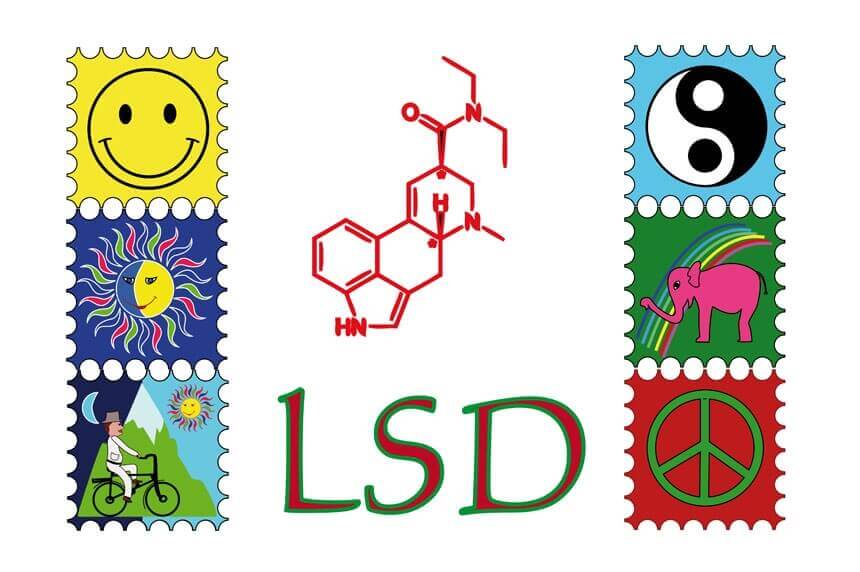Scientific Name:
D-Lysergic Acid Diethylamide
Other Common Names:
Acid, Trips, Microdots, Blotter, Boomers, Dots, Loony Toons, Golden Dragon, Heavenly Blue, Yellow Sunshine, and dozens of others
Description:
First synthesized in a laboratory in 1938, LSD is one of the most potent hallucinogenic drugs manufactured. It is made with lysergic acid that is mixed with an inactive substance that bulks up the acid and serves as the medium for drug delivery. LSD is first made as a crystal powder which is then turned into a hard form like pills and capsules or diluted as a liquid. The drug is odourless and colourless but does have a light bitter taste. It is a very powerful psychedelic drug that affects the mind and consciousness, and it does not take much to experience its effects.
 LSD works by binding primarily to the dopamine receptors and adrenal receptors in the brain. It also binds to most of the serotonin receptors. The binding process is believed to overstimulate the natural neurotransmission process, activating the receptors and altering thought and perceptions.
LSD works by binding primarily to the dopamine receptors and adrenal receptors in the brain. It also binds to most of the serotonin receptors. The binding process is believed to overstimulate the natural neurotransmission process, activating the receptors and altering thought and perceptions.
Though medical researchers have not scientifically proven how this process alters consciousness, they are certain about the binding process which links hallucinogenic chemicals to receptors and disrupts neurotransmission between receptors and parts of the brain.
Source:
LSD is manufactured from lysergic acid extracted from the fungus ergot which grows on grains like rye.
Forms:
LSD is sold in various forms. It may be a white powder but is usually converted to another form. Small tablets are called microdots. Gelatine squares, or LSD added to gelatine, are referred to as window panes. Loony Toons are small squares of absorbent paper soaked or dipped in LSD that are stamped with cartoon characters, smiley faces, or other cheerful designs. LSD is also available in liquid form and capsule form. The drug is sometimes added to sugar cubes. LSD is swallowed, sniffed, smoked, injected, and absorbed by placing an absorbent paper square on the tongue. The liquid can be rubbed into the skin, though this is not the common practice.
Health Effects:
- Psychological Effects:
- The effects of LSD are long-lived compared to many other common illicit drugs in that a “trip” may last up to 9-24 hours, with the peak “high” occurring within 60 minutes. One of its characteristics is its unpredictable effects. The drug’s effects occur within 30 to 90 minutes after use, and the psychological effects occur first. They include profound distortions in the perceptions of reality. The drug user may hear sounds or see images that are hallucinations. There are likely to be rapidly occurring mood swings, an altered sense of time, and confused senses in which the person “sees” sound or “hears” colours. Users describe feeling several emotions at once. One of the unpredictable impacts of LSD use is the user may go rapidly from having a good experience to a bad one. A bad experience (bad trip) will produce anxiety, despair, terror, fear of insanity, and distressing hallucinations.
- Physical Effects:
- Acute – The receptors that LSD binds to regulate body temperature, hunger, the behavioural system, motor control, and more. LSD users may develop dilated pupils, nausea, higher body temperature, increased blood pressure and heart rate, loss of appetite, increased blood pressure, insomnia, and tremors. Once LSD wears off, the person may experience acute depression or anxiety.
- Long-term – LSD is not addictive, but a tolerance can be built up to the drug. That leads to the drug user taking higher amounts of the drug while chasing the high. Some of the greatest danger with using LSD is due to the fact the person has an altered sense of reality and may do things that lead to personal injury or death. Users sometimes experience flashbacks days or months after last using LSD, and they can occur with no warning. In the worst cases, the LSD users experience long-term psychoses like depression or schizophrenia.
Detection Period:
Since LSD is used in very small doses, it is quickly metabolized by the human system. Taken as a pill, capsule or microdot, it is detectable as a hallucinogenic in urine for 8-24 hours after use. It is detectable by a saliva test for 1-2 days. In the case of LSD, the sooner the test is conducted after chemical use, the more likely it will be detected.
Legal Status:
LSD is an illegal drug in Australia. It is listed on Schedule 9 – Prohibited Substances. Schedule 9 substances are strictly prohibited except for government approved research purposes.
In Western Australia, it is against the law to possess, manufacture, supply, import or use hallucinogens like LSD. Possession offences are subject to a $2,000 fine and/or 2 years in prison. Supply offences are subject to a maximum $100,000 fine and/or 25 years in prison.
Other Information:
There are synthetic LSD-like hallucinogens appearing in the illicit drug market. The Australian federal government intends on banning four of the known substances advertised as N-Bomb, Smiles and Pandora. The synthetic drugs mimic the effect of LSD. The legislation will impose penalties that include fines and imprisonment for manufacturing, buying, or importing the synthetic LSD.



